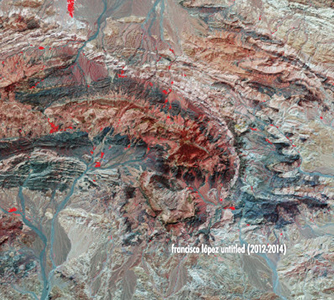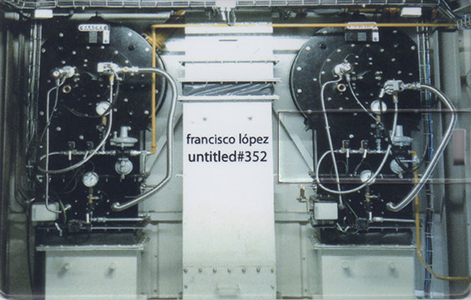 These two new releases from the legendary composer may have come out around the same time, but they both represent extreme ends of his work. The former is a two disc, 16 piece compilation of shorter works created over the span of two years, covering a wide gamut of the López sound. The latter is a flash drive containing a single work (split into 11 distinct parts) five hours and 20 minutes in length, all based on a single sound source. They may be distinctly different in composition and construction, but both are brilliant works in his already shining discography.
These two new releases from the legendary composer may have come out around the same time, but they both represent extreme ends of his work. The former is a two disc, 16 piece compilation of shorter works created over the span of two years, covering a wide gamut of the López sound. The latter is a flash drive containing a single work (split into 11 distinct parts) five hours and 20 minutes in length, all based on a single sound source. They may be distinctly different in composition and construction, but both are brilliant works in his already shining discography.
Untitled (2012-2014) is the more accessible of the two, or at least as much as that term can be applied to Francisco López’s often difficult work.Consisting of 16 pieces ranging from just shy of three minutes to a bit under 14, it functions well as a compilation or overview of the work he has been doing in that time span.One thing that does define these works (and seeps into Untitled #352 as well) is an intensive use of low frequencies.Listening on headphones (as recommended) results in some moments of near silent volume, but significant vibrations and rumbling.
One of the major reasons for the diversity of these two CDs is the differing sources of sound López utilized to create them.Four of the pieces stem from raw sound material provided by other artists that he radically reworked into his own compositions."Untitled #316 (for Zbigniew Karkowski)" uses material from the late composer (and friend of López) to create an expanse of low frequency that, without adequate headphones or speakers, would probably sound like complete silence.With the addition of shrill digital static, the piece builds to a harsh roar before falling back to the open space.At times I could not tell if what I was hearing was actually on the recording or sound of my headphones barely being able to handle the low end noise.
In a similar vein, "Untitled #297", using source sounds from the artist Shhh… is another pastiche of extreme frequencies.It functions almost as a study of significant contrasts, where foundation shaking low frequencies are paired with almost ultrasonically high register noises verging on the upper limit of human hearing.In truth, it is not too dissimilar to the approach of some of the earliest Whitehouse recordings, but here executed with a scientific, almost clinical precision.
Most of the remaining pieces are works derived from field recordings, although in a less obvious manner than Lopez has presented on his Epoché series of recordings in recent years.Here is where a significant amount of variation can be heard."Untitled #293", created from recordings made in Lima and Panama City, leads off with an almost startling lack of bass, but instead glistening, shimmering shards of noise.The volume rises and falls, and sounds almost resembling horns and pseudo-rhythmic segments appear, before the piece ends on a foundation rattling note.
There are also pieces included with less clear sources, but are no less engaging.Voices appear at erratic times throughout "Untitled #296", augmented by swirling tones and understated electronics.There is a notable amount of activity to be heard, though where it is coming from is anything but clear, ending with what sounds like a sharp spring reverb passage."Untitled #304" is at first what I would consider a "standard" López composition:a droning, almost air conditioner like din sets the mood as quiet electronic-tinged noises cut through.Later, however, and almost drum-like thump is introduced that gives an entirely different feel to the piece.
samples:

On the other hand is Untitled #352, a massive, monolithic work created from a single source:field recordings from an urban boiler plant facility at the Régie de Chauffage Urbain, near Paris.The final 20 minute segment of the five hour and 20 minute piece, the soundtrack to Exposure (a choreographic project by Anne Collod) is a mixdown of an originally 46 channel piece based on these recordings.The composition is an extremely dynamic one, blending rhythmic puffs of white noise and intersecting layers of varying recordings, piled together then stripped back and back again.At times the sound is an overwhelming combination of nearly every frequency in the sonic spectrum, and then others it is only the subtlest of pops and crackles.
The five hours that precede this is a series of ten 30 minute pieces, titled "MANTRAck" 01 through 10.The nature of these recordings is all in the title:each is a rework of the same source material, in long form structures with little overt variation.In that regard, they are excellent meditative pieces, having the "zone out" quality of white noise, but with enough change and variation within the pieces to keep them engaging.Most of the variation has to do with the frequencies:some cover more of the full frequency spectrum, such as the first.The opener is an abrasive, dissonant buzz that builds to an unmoving wall, while the quieter, more bassy foundation evolves and changes.
For the sixth piece, he emphasizes the mid and high end frequencies, resulting in a metallically shrill, almost painful bit of sound.On the third segment Lopez keeps the harsher moments at bay and instead emphasizes the more textural elements of the source recordings.This results in a more varied piece, where pops, clicks, and the occasional bit of (intentional) digital clipping result in a greater depth and variety.The final tenth segment is another pairing of extreme frequencies, but engineered in such a way as to be peaceful, rather than abrasive.
The two disc compilation Untitled (2012-2014) is the more inviting of these two works given its wider array of source material, but the magnitude and depth of Untitled #352 makes for a more challenging, yet overall more rewarding experience.To sound a bit cliché, the compilation is well suited for the casual listener or unfamiliar person interested in Francisco López’s daunting body of work, but can easily be appreciated by those who have followed him for awhile.Untitled #352 is likely going to be a bit off-putting for the uninitiated due to its intentionally static structure and sprawling duration, but fans will find much to appreciate.
samples:
 
Read More

